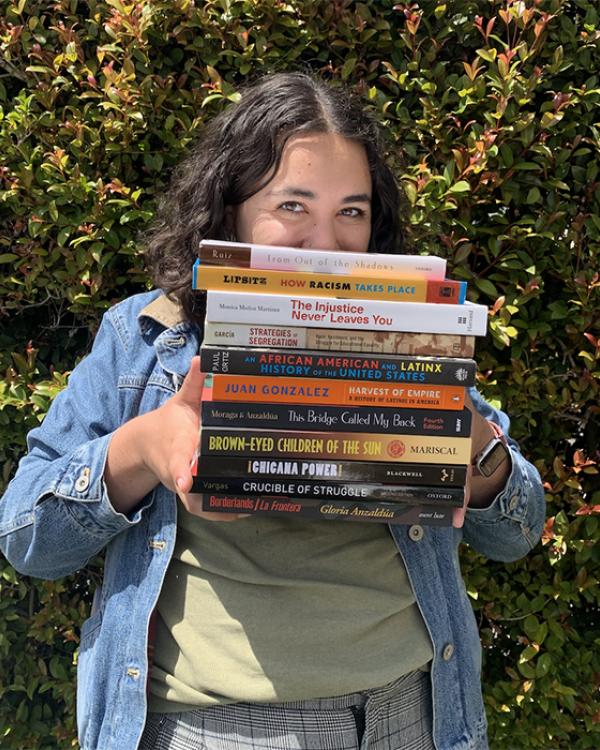
Miranda Vasquez didn’t think she’d ever step into a K-12 classroom again after graduating high school. “I’d never really felt like school was a place for where I fit in,” she explains, “I experienced racism, sexism, and homophobia from students and teachers. I didn’t see teachers who looked like me, and I was essentially alienated from my own education.” It wasn’t until after she had graduated from UC Santa Cruz and returned to Santa Barbara that she began to consider pursuing a teaching credential. “I always knew that I would come back here,” she says. “I didn't know I was going to be a teacher, but I've always wanted to return to the community that helped build me up.”
Vasquez’s history teachers fueled her passion for the subject and were a big reason why she pursued a B.A. in Critical Race and Ethnic Studies at UCSC. When Santa Barbara Unified School District introduced ethnic studies as a graduation requirement in 2018 (two years ahead of California’s statewide requirement), Vasquez decided to get a teaching credential. “I already love ethnic studies so much. I have such a deep passion for it. Seeing it made into a graduate graduation requirement in my hometown, I just felt almost like emotionally compelled to, you know, go back into the classroom and start teaching.” She says, “I saw ethnic studies and Santa Barbara Unified’s commitment to making ethnic studies a graduation requirement as a sort of a promise that they wanted to do better.”
Now, Vasquez is well on her way to a History/Social Studies teaching credential in the Teacher Education Program and going to two placements: one in a ninth-grade Ethnic Studies Literature class and one in an eighth-grade U.S. History class. And aside from the PLCs (Professional Learning Communities) associated with those positions, Vasquez is part of two others: Mexican American literature and Chicano studies. “We're actually going through and creating the courses for Chicano studies. We’re grappling with how we can have a Chicano studies course that meets the ethnic studies graduation requirement and, you know, qualifies as an American history class,” Vasquez explains. “How can we actually make a course that's centered in ethnic studies, that's centered on Chicano history, but that’s still an American history course? So making that course has been an amazing project we've been working on for a few months.”
Vasquez believes that developing the ethnic studies curriculum isn’t just about teaching students: it’s about challenging inequalities ingrained in the educational system. “Academia and public schooling, like traditional schooling in general, has been rooted in white supremacy. The fact of the matter is it is all rooted in white supremacy,” she says. “I do think there are places where academia can be pushed to challenge the white supremacy that it upholds, and I really feel that ethnic studies is one of the ways that the school system can challenge itself to turn inwards on itself and say, ‘Why do we need a whole separate class to learn about the histories of people of color, to learn about systems of oppression, to learn about systems of power?’
“I see ethnic studies as an opportunity for students to see a side of the world that they've just never learned about before,” she continues. “Whether that's students of color coming into an ethnic studies class and finally learning about people like themselves for the first time in their lives, or white students coming into a classroom and learning about people who don't look like them for the first time. I believe in the power of mirrors and windows: the idea that students need to see themselves reflected in classrooms and that students need windows into other realities.”
The ethnic studies English class Vasquez is placed in is already challenging students to do exactly that. The class features literature by authors of color written for young adults, and in addition to discussing poetic language and imagery, the class is taking on police brutality, privilege, and intersectionality. “We really just dive in with this book [All American Boys by Brendan Kiely and Jason Reynolds] and use this book to sort of learn, you know, what are we talking about when we talk about privilege? What are we talking about when we talk about dominant culture or white supremacy, what does that look like?” Vasquez admits that, without texts like that one, the conversations would be much more challenging to have with students, “It's easier when it's not talking about personal events. We are, of course, incorporating students' lived experiences, and they're open to sharing their lived experiences, but when we make it more about the text, it's a lot easier for students to step back and analyze.”
Vasquez wants all of her students to be able to analyze and apply their lessons outside of the classroom. “My teaching is so rooted in the foundations of ethnic studies. I really want my students to have the tools to be able to analyze global phenomena outside of the classroom,” she says. “I want them to understand how intersectionality as a concept can affect, you know, how they navigate the world, how everyone they've ever met and will ever meet navigates the world.”
In the future, Vasquez hopes to teach ethnic studies here in Santa Barbara so that she can continue to develop the curriculum. “I definitely see ethnic studies expanding, and I see myself expanding with it,” Vasquez says. “I see a lot more teachers of color. I see a lot of teachers who are really invested in centering students in their teaching. Vasquez hopes that these changes she sees in her own life reflect a larger shift towards an education system that is rooted in equity, justice, and liberation.”